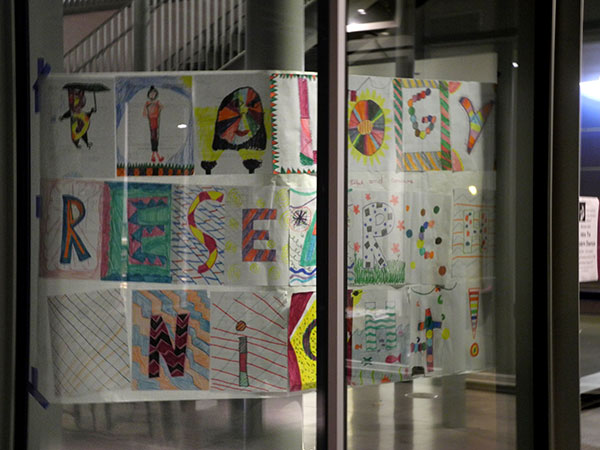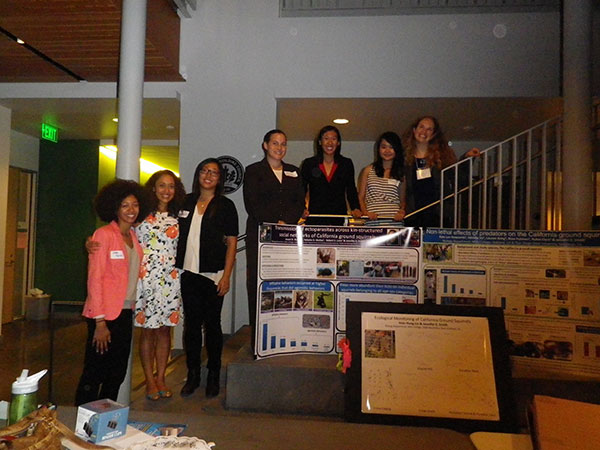Every year, Mills College hosts the Barrett Symposium, where biology students present the research they compiled over the summer to the Mills community in a series of five talks.

The annual symposium allows students not only to share the field and lab work they are conducting on campus and ideas for other projects, but it allows students from other fields to learn what ground-breaking technology is happening at Mills.
Dr. Jared Young, director of the Jill Barrett biology program, presented the 2013 Barrett Symposium on Sept. 11 where 10 undergraduate biology students presented their findings and fielded questions from fellow students, faculty and community members regarding their summer research through the Barrett program.
“In bringing together all these constituents, I felt a strong sense that the mission of Mills College is being accomplished with deep support from the Barrett Program,” Young said.
Young said he was pleased with how the night turned out; the turnout was large with over 125 students, faculty and community members in attendance, and he was proud of all the student speakers.
“The talks were fabulous,” said Young. “I was excited they had the opportunity to share the hard work they are doing with such a large Mills community.”

Students who attended the event also said they were proud of those who presented their research and that hearing about the research of their classmates inspired them to take their own scholarly careers to the next level at Mills.
Andria Lesser, a post-bac and pre-veterinary student, said that before she attended the event she was casual about taking advantage of opportunities on campus. But after hearing students’ presentations, Lesser said she was “inspired and motivated to start taking advantage of opportunities at Mills.”
Another student, Tia Barfels, also said the talks were interesting. Barfels is a second-year student considering a major in either biochemistry (because she is interested in delving into the idea of how things work on a smaller level) or biopsychology (because she also has interest in social behavior). After the event she said that student presentations made her “eager to take upper division biology classes at Mills,” and decide on a major.
The Jill Barrett Biology Research Program, initiated in 1998, is one of the reasons students can conduct field and lab research at Mills. This program is unique — it was founded in 1998 in memory of a Mills alum (Jill Barrett, 1993) who met an untimely death while actively engaged in the conservation of sea turtles worldwide.
The Barrett Program supports students by providing scholarships, including paid stipends, to students accepted into a 10-week long summer research project guided by a faculty member from the biology department. Students prepare for their summer project by doing yearlong research with individual faculty members to prepare for the project, according to the Mills website.

Lisa Urry, Mills biology professor and head of the biology department, said since 1998, the Barrett Program has benefitted about 125 students.
“Many students who never realized research was a professional option have had their eyes opened to this possibility, and have experienced great joy in grappling with fascinating questions about how life works,” said Urry. “We are deeply honored to remember Jill in this way — by encouraging Mills students in their research pursuits under the close mentorship of a faculty investigator.”
The Barrett program has been so successful over the 15 years since it began that the Barrett Foundation has increased its support by over 50 percent this past year, according to Urry. The Foundation also uses the program’s structure as a standard nationwide for undergraduate research programs that they support.
Currently under the able leadership of Jared Young, said Urry, the Barrett biology research Program continues to attract and benefit many students every year.
“Being immersed in a novel research project provides a unique experience and many opportunities for personal and professional growth,” Young said. “I am grateful to the many students who have dedicated themselves to their research and to the program — it is their work that has made this program a success.”
“I would say the Barrett Research Program is the jewel in the crown of the biology department,” Urry said.

Students who attended the event were inspired by the research students were doing on campus and were enthusiastic about what else might be going on at Mills behind the scenes.
Ashley Morgan, a third-year student majoring in biopsychology, was glad she attended the event. “I thought the presentations were informative and inspiring,” Morgan said, adding that she didn’t realize there was such big research going on at Mills, and by students.
Another student, Hannah Hanson, a first-year majoring in biology, also said that the presentations made her really excited about doing fieldwork.
The presentations “reaffirmed Mills is the right place to be,” Hanson said.
Also in attendance was community member Phil Leitner, a biologist and recent retiree from St. Mary’s faculty. Leitner has also conducted research on ground squirrels in the Mojave desert, similar to work being conducted by Mills associate biology professor Jennifer Smith on California ground squirrels.
Leitner said student field and lab work is a fantastic way for under graduates to learn about research: “It’s a way of learning outside the classroom [that’s] really amazing, Mills should be pleased with this program.”
“I am amazed and pleased with the quality of work students are doing,” Leitner said.
After presentations, a panel of four Mills and Barrett program alumni spoke about their experiences with the Barrett program, what they accomplished after graduating from Mills and fielded questions from students about research and their journey into biology.

During the question and answer session, Young said he was overwhelmed with gratitude to the Barrett Foundation for making it possible to provide such a space for students to explore science and that he was overjoyed with the success of the event.
“It was wonderful to feel the strength and energy of our Mills community galvanized around our science,” Young said. “The whole community was there: our current Barrett students who gave outstanding presentations on their work, alumnae who returned to tell us how they are applying their experiences in their careers and seeing how the projects they began continue to endure and progress, first-year students and sophomores in the audience who are now embarking on their journeys, and faculty who have guided all these students along the way.”
Student and faculty research completed through the Barrett program will be detailed through an in-depth explanation of the research process students experienced and hypothesis in a four-part series. The words “field research” have been edited to reflect “laboratory and field research” as most students are doing lab research as well if not in lieu of field research.
Part One of the series will detail research completed by Julia Harenčár under the PI Sarah Swope on the effects of pollen with Calochortus tiburonensis.
Part Two of the series will detail research completed by Jillian Steele and Simmone Dyrness under the PI Susan Spiller on tagging actin and tubulin with Bioengineered fluorescent protein tags from Cyanobacteriochromes from T. elongates.
Part Three of the series will detail research completed by Jamie Knight and Liz Newman under the PI Jared Young on characterizing odor sensations in newly generated Caenorhabditis elegans mutants.
Part Four of the series will detail research completed by Team Squirrel: Imani Russell, Valeska Muñoz, Kate Lee Newcomb, Minnie Vo and Lauren Kong under the PI Jennifer Smith on disease transmission through kin-structured social networks and non-lethal effects of predation on the California ground squirrel.
For more photos, check out our Flickr album:
Correction as of Oct. 15: Dr. Jared Young, director of the Barrett Foundation has been corrected to reflect that Dr. Jared Young is director of the Jill Barrett biology research program; Dr. Young is the director of the program at Mills, not the Barrett Foundation as a whole. Also, “field work” had been amended to say “field and lab work” as some students do lab work only or as well as field work.

